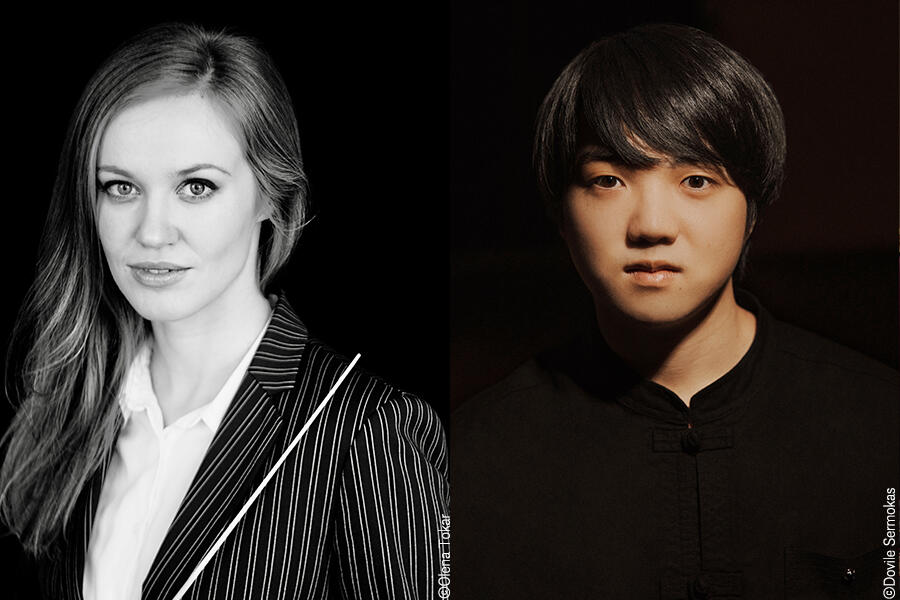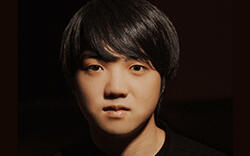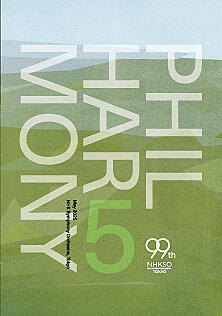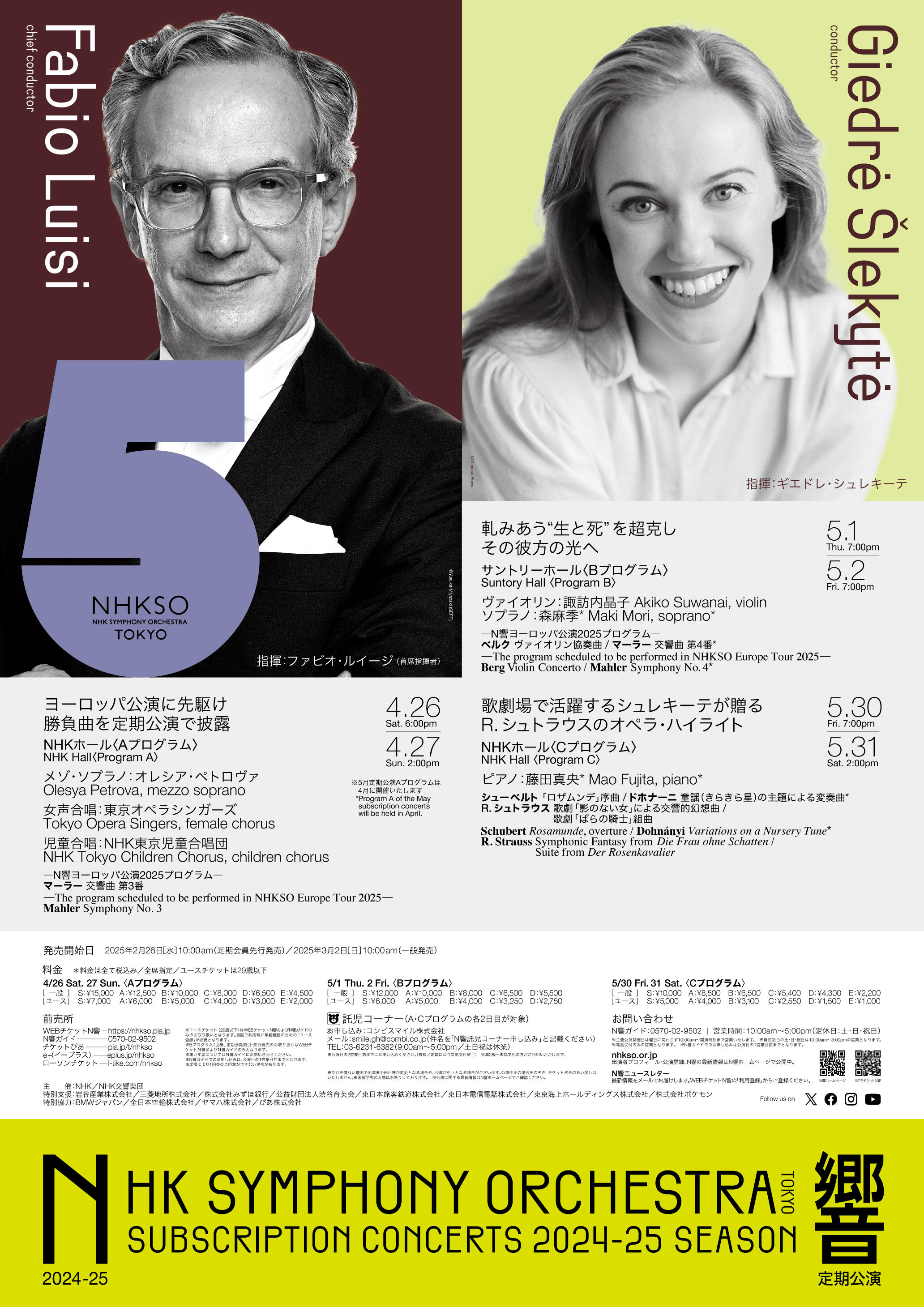- Home
- Concerts
- Subscription Concerts 2024-2025
- Program C
- No. 2038 Subscription (Program C)
Subscription Concerts 2024-2025Program C
No. 2038 Subscription (Program C)

Program
Schubert / Rosamunde, overture
Born in Vienna, Franz Schubert (1797–1828) led a short but astonishingly prolific life leaving us as many as around 600 Lieder (German songs). However, it is not well known that the composer of the breathtakingly dramatic song Der Erlkönig (The Erlking) also applied himself to writing theatrical music (opera, Singspiel and incidental music). Worth specific mention is that Schubert as a boy studied composition under the Italian opera master Antonio Salieri (1750–1825) who was the Viennese Court’s music director.
1819–1820 was a period Schubert was especially enthusiastic about composing for stage, one of the fruits being the incidental music for the three-act play Die Zauberharfe (The Magic Harp). He wrote the music in the summer of 1820 at the request of the Theater an der Wien where this “Zauberspiel mit Musik (magic play with music)” was staged eight times the same year. The overture to the first act is well-accepted today as the one for Rosamunde, Fürstin von Zypern (Princess of Cyprus), because it was reused as so at the publication of Schubert’s incidental music for this play.
The overture has a slow, solemn introduction in C minor. The main Allegro section in C major is a sonata with the cheerful first theme (introduced by violins) and the calmer songful second theme (given by woodwinds). Interestingly, the music is reminiscent of Schubert’s Overture in the Italian Style No. 1 in D major (1817), a work reflecting his craze for another Italian opera master Gioacchino Rossini (1792–1868).
[Kumiko Nishi]
Dohnányi / Variations on a Nursery Tune, Op. 25*
The Hungarian composer Ernst von Dohnányi (1877–1960), four years older than his compatriot Béla Bartók (1881–1945), was trained at the Budapest Academy founded by Franz Liszt. Dohnányi’s “opus 1,” the Piano Quintet in C minor written in his late teens (1895), received acclaim from Johannes Brahms (1833–1897) who set the stage for its premiere in Vienna. In contrast to Bartók whose compositions were often rooted in folk music, Dohnányi’s style follows in the wake of the 19th-century German Romanticism under the strong influence of Robert Schumann and, above all, Brahms.
Dohnányi also left his mark on history as one of the greatest virtuoso pianists ever. His 1898 successful appearance in London as the soloist of Beethoven’s Piano Concerto No. 4 set off the former’s long-term stardom as a concert pianist in Europe and USA. His most notable achievements are the performances of all Beethoven’s piano works (1920) and all Mozart’s twenty-seven piano concertos (1941).
Dohnányi wrote the Variations on a Nursery Tune in his late thirties in 1914 during the period when he, an excellent educator as well, taught at the Berlin Hochschule at the invitation of the Hungarian violinist Joseph Joachim (a close friend of Brahms). Dohnányi himself served as the soloist of the Variations at the 1914 premiere in Berlin, fully showcasing his high musicality both as a composer and pianist.
What Dohnányi inscribed on the manuscript—“For the enjoyment of friends of humor, to the annoyance of others”—is very suggestive. The orchestral introduction is amazingly majestic, prior to the startlingly simple announcement of the theme (Twinkle, Twinkle, Little Star / Ah vous dirai-je, Maman) by the piano. Then the eleven variations and the finale come. On occasions, Dohnányi’s witty pen vaguely evokes styles of certain famed composers, such as Richard Strauss (Introduction), Liszt (Variation 1), Brahms (Variation 3, Variation 10 – a passacaglia), Johann Strauss (Variation 7 – a waltz), Tchaikovsky (Variation 8 – a march) and Debussy (Variation 11 – a chorale). Opened by some Beethovenian introductory gestures, the vivacious Finale is a fugue over which the pianist unfolds a restless virtuosic passagework. The return of the theme in its original form, again startlingly simple, leads to the sparkling conclusion full of humor.
[Kumiko Nishi]
R. Strauss / Symphonic Fantasy from Die Frau ohne Schatten (The Woman Without a Shadow)
Born in Munich, Richard Strauss (1864–1949) was a long-lived and prolific composer. The eminent orchestrator fully explored possibilities of musical narrativity in the genre of symphonic poem during the early stage of his career. Then the focus of his composition shifted to the opera leaving us fifteen works in total. The artistic partnership between him and the Austrian dramatist-poet-librettist Hugo von Hofmannsthal (1874–1929) became history in particular from their first collaboration Elektra (1908). It was followed by their six masterworks including after-mentioned Der Rosenkavalier (1910) and Die Frau ohne Schatten (1917).
For the plot of Die Frau ohne Schatten, a quest for humanity and love, Strauss and Hofmannsthal were inspired by Mozart’s The Magic Flute. In 1919, Strauss was appointed co-director of the Vienna State Opera where Die Frau ohne Schatten was world-premiered the same year. (Incidentally, the 1984 Japanese premiere of the opera was under the baton of Christoph von Dohnányi, a grandson of above-mentioned Ernst von Dohnányi.)
The story of the opera is about the Emperor and the “shadowless” Empress, daughter of Keikobad (King of the Spirit Realm). Here the shadow is synonymous with the ability to give birth. Keikobad puts a curse on the newlywed couple so the Emperor would be stone unless the Empress gets a shadow within a year. The subplot features a mortal couple going through a marital crisis: the Dyer and his Wife. Although endowed with a shadow, the Wife swears not to have any child. The Empress, in disguise, goes down to the human world and asks the Dyer’s Wife to sell her the shadow, but ends up abandoning the plan for the sake of the Dyer couple. The Empress’s self-renunciation brings about miracles: she obtains a shadow, the Dyer couple restores a lost love and the two couples are happily reunited.
The Symphonic Fantasy for orchestra was prepared by the composer himself in his closing years in 1946. It was partly to compensate for the infrequency of the opera being staged due to its large scale, highly demanding vocal parts, gigantic orchestra and intricate, symbolic plot. A sort of symphonic poem based on the opera, the Fantasy begins with one of the important leitmotifs (recurrent melodic or/and harmonic elements representing certain characters, situations, feelings or so): the grave, descending three-note motif representing Keikobad. Interestingly enough, the rest of the Fantasy is mainly built of leitmotifs linked to the Dyer and his Wife presumably modeled on Strauss’s own wife Pauline. Furtheremore, the Fantasy reaches its climax with the Dyer couple’s lyrical love duet Mir anvertraut (Entrusted to me) from the final act of the opera.
[Kumiko Nishi]
R. Strauss / Suite from Der Rosenkavalier (The Rose-Bearer)
The opera Der Rosenkavalier was a turning point in Richard Strauss (1864–1949)’ stylistic transition. As opposed to the grisly, almost atonal predecessor Elektra, Der Rosenkavalier was viewed as a Mozartian comedy by the composer and his librettist Hofmannsthal. This, so to say, “Marriage of Figaro wearing late-Romantic clothes” incited contemporary critics to accuse Strauss of stylistically regressing, while its 1911 premiere was an unexampled success among the audience.
The opera is set in 18th-century Vienna. The title refers to an imaginary noble custom for a suitor to send a messenger with a silver rose to the bride-to-be. The center of the bittersweet story is Marschallin, a marshal’s wife, having an affair with the teenage Count Octavian. He, by recommendation of his mistress, becomes a Rose Cavalier for Baron Ochs and presents the rose to beautiful young Sophie. Octavian and Sophie fall in love with each other at first sight. Marschallin, heartbroken, has the grace to accept reality.
The orchestral suite performed today is the one prepared anonymously in the mid-1940s and authorized by Strauss. Without any break, it appears to be a symphonic poem freely treating some highlights and waltzes from the original. The suite starts with a famous lovemaking part from the opera with the youthful ascending theme of Octavian (horns) and the refined descending theme of Marschallin (strings) entangled. Later we hear the recurring glittering motif of the silver rose played mainly by flutes, harps and celesta.
[Kumiko Nishi]
[Encore]
May 30: Déodat de Sévérac / Stances à Madame de Pompadour
May 31: Wagner / Albumblatt in C Major, In das Album der Fürstin Metternich
Piano: Mao Fujita
Artists
 ConductorGiedrė Šlekytė
ConductorGiedrė Šlekytė
Giedrė Šlekytė, who will conduct the NHK Symphony Orchestra for the first time, was born in Vilnius, Lithuania. After studying at an art school named after Mikalojus Čiurlionis, the composer of her native land, she pursued further studies in conducting at institutions including the University of Music and Performing Arts Graz, and the Zurich University of the Arts, winning many prizes in international conducting competitions. From 2016 to 2018, she served as 1st Kapellmeister at Stadttheater Klagenfurt, and went on to assume the position of Principal Guest Conductor of the Bruckner Orchester Linz in 2021.
She has been assigned to conduct new opera productions at the Oper Frankfurt and the Bayerische Staatsoper, and in the 2024–25 season, she made a debut at the Wiener Staatsoper, and has been scheduled to return to the Staatsoper Unter den Linden. Thus she has been quite active in the operatic field while also vigorously developing her career as a concert conductor. Her first visit to Japan was in 2021 when she conducted Tokyo Nikikai Opera Foundation’s Die Zauberflöte, then on her visit in 2023, she guest-conducted the Yomiuri Nippon Symphony Orchestra. She also enjoys works of her contemporary composers and has released CDs of works by Žibuoklė Martinaitytė and Raminta Šerkšnytė.
The program of the subscription concert she will conduct has a line-up of works which will please the audience with the ingenuity of orchestration such as orchestral music based on R. Strauss’ operas, and a masterpiece of Dohnányi who was also a virtuoso pianist. Expectations are high on how Šlekytė, who weaves music vivaciously while sending cues in an agile and supple manner, will present music.
[Nobuyasu Matsuoka, music critic]
 Piano*Mao Fujita
Piano*Mao Fujita
Mao Fujita, a 26-year-old pianist born in Tokyo, won First Prize at the prestigious Clara Haskil International Piano Competition in Switzerland along with other prizes including the Audience Award in 2017 when he was still at the Tokyo College of Music. He came to global attention when he won 2nd Prize at the 16th International Tchaikovsky Competition in 2019, and since then, he has worked under the batons of the world’s most prominent conductors, such as Riccardo Chailly, Christoph Eschenbach, Andris Nelsons, Charles Dutoit, and Semyon Bychkov, and with leading orchestras at home and abroad, including the Royal Concertgebouw Orchestra, Gewandhausorchester Leipzig, Münchner Philharmoniker, NHK Symphony Orchestra, Tokyo Metropolitan Symphony Orchestra, and Yomiuri Nippon Symphony Orchestra. He has also been invited to festivals, such as the Lucerne Festival, Verbier Festival, Edinburgh International Festival, and the BBC Proms. He enjoys a wide repertoire ranging from the music of Mozart, which is sometimes described as naive exuberance, to that of Scriabin, often characterized as music of ecstasy, and he vividly expresses works in his performances with detailed interpretation and solid technique. And he is expected to brilliantly deliver Dohnányi’s music, a work in which familiar themes will opulently develop. This is his first collaboration in 4 years with the NHK Symphony Orchestra since performing in 2021.
[Arisa Iida, music facilitator]
Download
Ticket
Program C
No. 2038 Subscription (Program C)
NHK Hall
Google Map
Seating Chart
Single Tickets Release Date
Pre-sales for Subscribers:Wednesday, February 26, 2025
*about subscribers
Sale to General Public:Sunday, March 2, 2025
Price
| S | A | B | C | D | E | |
|---|---|---|---|---|---|---|
| Ordinary Ticket | 10,000 | 8,500 | 6,500 | 5,400 | 4,300 | 2,200 |
| Youth Ticket | 5,000 | 4,000 | 3,100 | 2,550 | 1,500 | 1,000 |
Seating chart Enlarge Print PDF
*tax included
*Subscribers receive a 10% discount (Available at NHKSO WEB Ticket and N-Kyo Guide)
*For wheelchair-accessible seats, please refer to the N-Kyo Guide
Youth Tickets
Youth Tickets are great options for those of 29 years old and younger
Subscription tickets
Release Date
ANNUAL SUBSCRIPTION TICKETS
Mon., July 15, 2024 10:00am
[For Subscribers: Sun., July 7, 2024 10:00am]
SEASONAL SUBSCRIPTION TICKETS (SPRING)
Wed., February 19, 2025 10:00am
[For Subscribers: Thu., February 13, 2025 10:00am]
Where to buy
NHKSO WEB Ticket | Friday, May 30, 2025 (In English / Seats not selectable)
NHKSO WEB Ticket | Saturday, May 31, 2025 (In English / Seats not selectable)
NHKSO WEB Ticket (In Japanese only / Seats selectable)
N-Kyo Guide (Purchase by telephone only)
Other Ticket Agents
Broadcast
 NHK-FMNo. 2038 Subscription (Program C)
NHK-FMNo. 2038 Subscription (Program C)
Saturday, Jun 7, 2025 4:00PM - 5:50PM
Program:
Schubert / Rosamunde, overture
Dohnányi / Variations on a Nursery Tune, Op. 25*
R. Strauss / Symphonic Fantasy from Die Frau ohne Schatten (The Woman Without a Shadow)
R. Strauss / Suite from Der Rosenkavalier (The Rose-Bearer)
Conductor:Giedrė Šlekytė
Piano*:Mao Fujita
Recorded:May 30, 2025 NHK Hall
*Repertoire, conductor, soloists and program order are subject to change without notice.
*Pre-school children are not allowed in the concert hall



